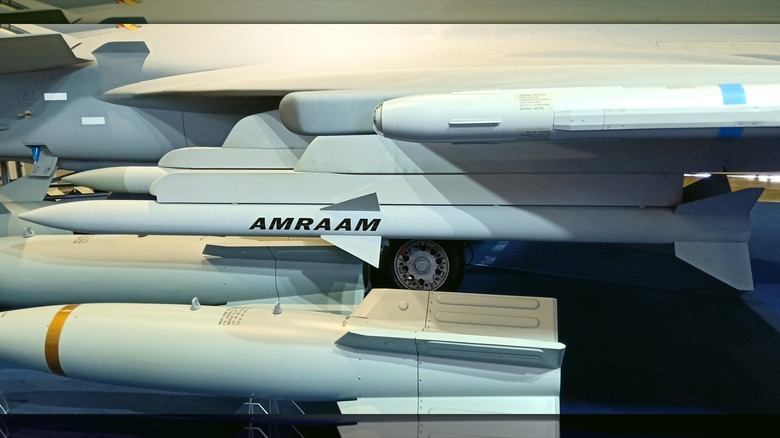What Missiles Do F-22 Fighter Jets Carry? (And Are They Big Enough To Carry Nukes?)
The F-22 Raptor is the world's first 5th-generation jet fighter, and the stealthiest fighter jet ever built. The F-22 entered active service in 2005, and it continues to support U.S. military operations worldwide. The F-22 is a marvel of 21st-century engineering, and many of its capabilities helped inform the development of subsequent aircraft like the F-35 Lightning II. The F-22 is an air superiority fighter, which means that its primary focus is to establish air superiority in contested airspace through tactical dominance.
Because of this, the F-22 is primarily armed with air-to-air missiles that allow it to engage airborne threats in close and extended ranges from its position. While that's its primary function, like most American aircraft serving one main role, the F-22 can serve multiple purposes, including ground attack, signals intelligence collection, and electronic warfare. It employs a variety of sensors and equipment to function in those roles, and because it's a versatile aircraft, it's sensible to assume it can carry non-conventional weapons.
The F-22 was never designed to be a nuclear warhead delivery system, though its initial design was meant to replace the nuclear-capable F-16 Fighting Falcon, which is still widely used. While the F-22 isn't currently capable, it could potentially carry a single nuclear bomb, though it would require certification and modifications. If it were to carry a nuclear bomb like the newly-certified F-35, it would be the B-61 tactical nuclear bomb, which was designed to fit in planes like the F-16 and is used in NATO's nuclear weapons sharing program.
The F-22's standard armaments
The F-22 can carry a lot of weapon systems within its internal bays, and while this can include a variety of bombs, its primary duty is to engage in aerial dogfighting with other aircraft. The fighter's air-to-surface weapons are designed to take out air defenses, so it's equipped to perform both actions in most situations. A standard payload for the F-22 includes a 20mm cannon and 480 rounds for close-quarters engagement; the internal side weapon bays can carry two AIM-9 air-to-air missiles, which are heat-seeking. The internal weapon bays can hold six AIM-120 radar-guided air-to-air missiles.
If desired, the internal weapon bays can carry two 1,000-pound GBU-32 Joint Direct Attack Munitions (JDAM) bombs and two AIM-120 missiles instead. Either loadout is what you'd expect to see when the F-22 is used in an air-superiority role, where it needs to engage other aircraft or strike ground-based missile defense systems. As of June 2025, no F-22 has shot down an enemy aircraft, as they've largely been involved in ground-strike operations despite more than 500,000 flight hours since their introduction.
That said, F-22s did shoot down a Chinese spy balloon off the coast of South Carolina in February 2023, and another unidentified object was downed over Alaska. Unfortunately, these aren't dogfighting kills, so the F-22's combat record reflects that. While the F-22 hasn't always performed the primary role for which it was designed, it remains a highly capable 5th-generation fighter that can take out all kinds of targets.
The nuclear option
The F-22 is currently not certified to carry a nuclear bomb, as that capability exists only for the F-35 Lightning II fighter jet. The B-61 is a variable-yield nuclear weapon capable of delivering an explosive yield of between 0.3 and 340 kilotons. For historical comparison, the first nuclear bomb used in combat, "Little Boy," which was dropped on Hiroshima, Japan, during World War II, had an explosive yield of 15 kilotons. If a B-61 were dropped on New York City with its lowest yield, the explosive damage would be several magnitudes smaller than the Hiroshima bomb.
Nuclear Secrecy maintains a tool called Nukemap to determine the blast, fireball, and damage radii of nuclear weapons. Using that, it's easy to determine the total area damaged based on location, yield, and other factors. If you dropped such a bomb in the center of Central Park, the total area you'd damage would be around 0.75 square miles. If you were to dial up the yield to maximum, the blast radius would increase to just over 81 square miles, taking out most of Midtown.
The B-61 has been around since the 1960s, and thankfully, nobody has dropped one in anger on a city. Throughout its life, the B-61 has been upgraded, modernized, and maintained to ensure the United States' nuclear arsenal remains ready should it ever be needed. If that day comes, using F-22s to carry nuclear bombs would add another arrow to the quiver of America's Nuclear Triad. Still, the aircraft isn't ideal for nuclear warfare, so it's unlikely to happen while the F-35 remains active.


